Google Trends is the only keyword research tool that offers insights based on actual Google search data.
These seven tips on how to use Google Trends will show you how to extract real keyword trends that are accurate and will be useful for creating keyword strategies for promoting websites.
Discover new ways to use Google Trends to unlock hidden insights and keyword volume data.
The Value of Google Trends
While Google Trends is accurate, it doesn’t show the amount of traffic in actual numbers.
Paid SEO tools provide numbers for keyword search volume. But those numbers are estimates that are extrapolated from data providers.
So even though paid SEO tools provide estimates of keyword traffic, the data presented by Google Trends is based on actual search query volumes.
That’s not to say that Google Trends is better than paid keyword tools. When used together with paid keyword tools, one can obtain a near accurate idea of true keyword search volume.
Advertisement
Continue Reading Below
There are other functions in Google Trends that can allow accurate segmentation of the keyword data in order to understand what locations to focus promotional efforts, and also to discover new and trending keywords.
How to Use Google Trends for SEO
1. Get More Accurate Data by Comparing Keywords
Google Trends shows a relative visualization of traffic on a scale of zero to one hundred.
You can’t really know if the trend is reporting hundreds of keyword searches or thousands because the graph is on a relative scale.
This is especially helpful if you know the amount of traffic from another keyword phrase.
How to Obtain More Accurate Traffic Data
If you want to obtain a more accurate estimate of keyword search volume, compare the keyword with a keyword that you already have accurate volume numbers for.
If the keyword volume is especially large, there’s another way to identify a close estimate of keyword volume – by comparing your target keyword with any keyword phrase that you have an idea of traffic volume.
Advertisement
Continue Reading Below
The comparison keyword doesn’t have to be related. It can be completely different. The important thing is to have a general idea of the keyword volume.
In the event that this volume information is unavailable, here is a hack for getting an idea of search volume.
Go to the Google Trends Daily Trends webpage, which shows trending search queries.
What’s useful about this page is that Google provides keyword volumes in numbers, like 100,000+ searches per day, etc.
Here’s an example:
Google Trends shows that the keyword search trend for [womens dresses] is trending upward. But it doesn’t tell you by how much volume.
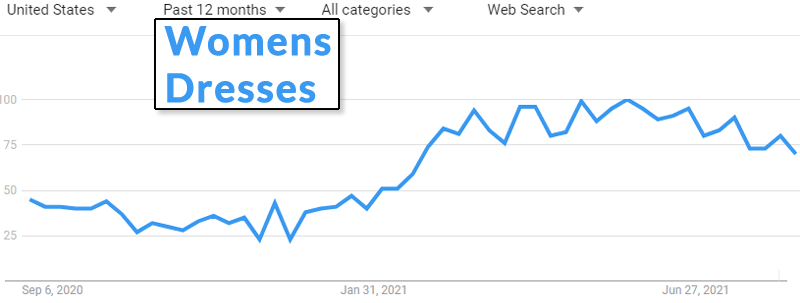 Screenshot from Google Trends, August 2021
Screenshot from Google Trends, August 2021The Google Daily Trends page for Monday, August 30, 2021 shows that searches for [elizabeth holmes] are trending at 100,000+ searches.
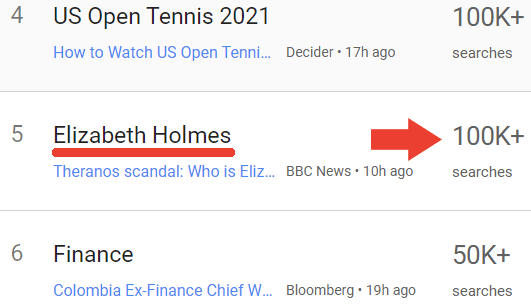 Screenshot from Google Trends, August 2021
Screenshot from Google Trends, August 2021Now, here is a screenshot of a comparison between the search query [womens dresses] and [elizabeth holmes], which is trending at 100,000+ searches.
 Screenshot from Google Trends, August 2021
Screenshot from Google Trends, August 2021Although Google Trends won’t show you the exact amounts, as long as you know the amounts for one keyword, the traffic levels of the other keyword will become more understandable.
The above hack isn’t 100% accurate. But it’s enough to give a strong ballpark idea and can be used to validate extrapolated data from a paid keyword research tool.
Related: How to Do Keyword Research for SEO
2. Compare Keywords by Time for Audience Insights
There are two general ways to look at the keyword data: stretched across over longer periods of time and shorter time periods.
Long Period Trends
You can set Google Trends to show you the traffic trends stretching back to 2004. This is valuable for showing you audience trends.
- Upward Trending Long-Term Trends: If a trend is going up this means to focus energy on creating content for this trend.
- Downward Long-Term Trends: If the trend line is moving down, then it may be a signal that audience content consumption is changing.
For example, review this five-year trend for WordPress the search term, WordPress the software, and WordPress the website:
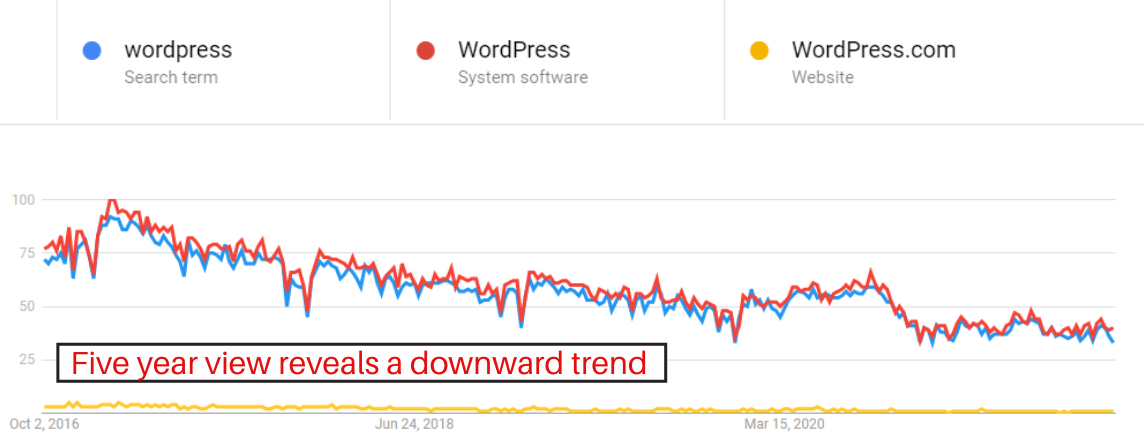 Screenshot from Google Trends, August 2021
Screenshot from Google Trends, August 2021There’s a clear downward trend for WordPress in all its variations. The downward trend extends to phrases such as WordPress themes, WordPress plugin, and WordPress hosting.
Advertisement
Continue Reading Below
It’s super important to understand when a trend is on a downward spiral.
- The digital camera started the demise of the traditional analog camera.
- The iPhone started the downward spiral of the digital camera.
Knowing which way the wind is blowing could help a content marketer or publisher understand when it’s time to bail on digital cameras and start flogging products related to mobile phones.
Related: Content Marketing: The Ultimate Beginner’s Guide
3. Related Topics and Queries
Google Trends has two great features, one called Related Topics and the other Related Queries.
Topics
Topics are search queries that share a concept. In general, topics are language-independent but it’s unclear if that’s the case with Related Topics.
According to Google:
“Related Topics
Users searching for your term also searched for these topics.
You Can View by the Following Metrics
Top – The most popular topics. Scoring is on a relative scale where a value of 100 is the most commonly searched topic and a value of 50 is a topic searched half as often as the most popular term, and so on.
Rising – Related topics with the biggest increase in search frequency since the last time period.
Results marked “Breakout” had a tremendous increase, probably because these topics are new and had few (if any) prior searches.”
Advertisement
Continue Reading Below
Related Queries
The description of Related Queries is similar to that of the Related Topics.
Top queries are the most popular in general and Rising Queries are queries that are becoming popular.
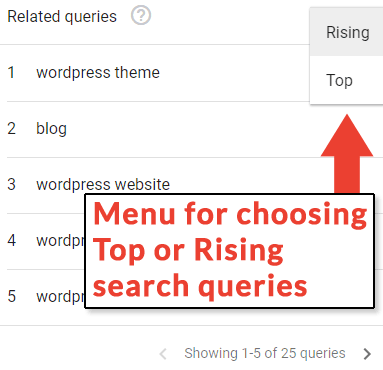 Screenshot from Google Trends, August 2021
Screenshot from Google Trends, August 20214. Short Term Trends Can Bring Massive Traffic
Viewing keyword trends in the short view, such as the 90 day or even 30 day view can reveal valuable insights for capitalizing on rapidly changing search trends.
Advertisement
Continue Reading Below
There is a ton of traffic in Google Discover as well as in Google News.
While Google Discover is less sensitive to trending topics than Google News, being on top of current interests is super helpful for grabbing a huge amount of traffic right now through Google Discover and Google News.
For example, two of the top trending keyword trends are How To and Near Me searches.
When you scale down to the 90-day view, you can see which days of the weeks those searches are popular.
Knowing which days of the week interest spikes for a given topic can also help in planning when to publish certain kinds of topics so the content is right there when the audience is searching for it.
5. Keywords by Category
Google Trends has the capability to narrow down your keywords according to categories in order to give more accurate data.
The Categories tab is important because it refines your keyword research to the correct context.
Advertisement
Continue Reading Below
If your keyword context is automobiles then it makes sense to appropriately refine Google Trends to show just the data for the context of auto.
By narrowing the Google Trends data by category, you will be able to find more accurate information related to the topics you are researching for content.
6. Leverage Keyword Data by Geography
Google Trends keyword information by geographic location can be used for determining what areas are the best to outreach to for site promotion or for tailoring the content to specific regions.
For example, if certain kinds of products are popular in Washington D.C. and Texas, it makes sense to aim promotional activity and localized content to those areas.
Keyword popularity information by region is valuable for link building, content creation, content promotion, and pay-per-click.
Localizing content can make it more relevant to people interested in that content.
Google ranks pages according to who it’s most relevant for, so incorporating geographic nuance into your content can help it rank for the most people. Especially if those people begin to promote your content in social media, blogs, and podcasts.
Advertisement
Continue Reading Below
Related: International SEO for 2021 & Beyond: 9-Point Checklist for Success
7. Uncover Search Intents With Categories
Google Trends gives you the ability to further refine the keyword data by segmenting it by Search Type, which is an incredibly useful way to research the popularity of various kinds of search intents.
Search Types give you insights into searchers when they are intensely focused on a specific kind of intent.
Refining your research allows you to remove the “noise” that might be polluting your keyword research and go straight to the signal – the data that is most meaningful.
Google Trends data can be refined by:
- Web Search.
- Image Search.
- News Search.
- Google Shopping.
- YouTube Search.
YouTube search is a fantastic way to identify the “how to” content.
A Google Trends search for how, what, where, when, why, and who shows that search queries beginning with the word “how” are by far the most popular on YouTube.
Advertisement
Continue Reading Below
Google Trends limits comparisons to five keywords, so the following screenshot omits that word.
 Screenshot from Google Trends, August 2021
Screenshot from Google Trends, August 2021If your keyword phrases involve instructional content that uses words like [how to], refining your research to YouTube may provide useful insights.
For example, I have found that YouTube Search shows more relevant “related topics” and “related queries” data than researching with “web search” selected.
Here’s another example of how using different kinds of search types helps refine Google Trends data.
Advertisement
Continue Reading Below
I did the same how, what, where, when, why, and who searches but this time using the News Search refinement.
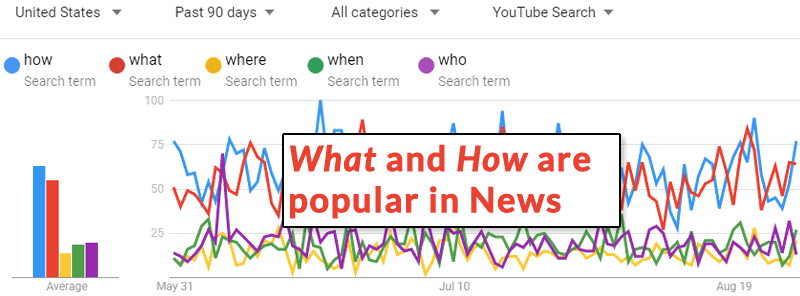 Screenshot from Google Trends, August 2021
Screenshot from Google Trends, August 2021The search trends in Google News are remarkably different than the search patterns in YouTube. That’s because people want to know “what” and “how” type information in Google News.
The above is the view of search queries for the past 90 days. When the same keywords are searched using the 5-year perspective it becomes clear that the “who” type keywords tend to spike according to current events.
Advertisement
Continue Reading Below
The biggest spike occurred in the days after the 2020 presidential election.
All of the different search type query refinements help to refine the results so that they show more accurate information.
So give those selections a try because the information they give can be more accurate and useful than the more general and potentially noisy “web search” version.
Takeaway: Google Trends is Useful
Google Trends is a useful tool, and a little creativity yields important search marketing insights.
Spend some time with Google Trends. I’m certain you’ll discover insights that will improve how content is created and promoted online.
More Resources:
Featured image: alphaspirit.it/Shutterstock
